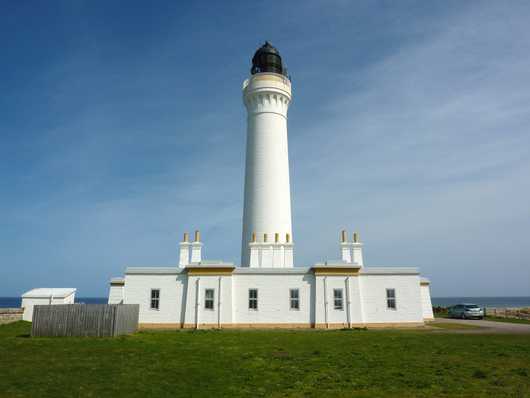Covesea Skerries

Requests had been made for a light following the wrecking of 16 vessels in a violent storm on the Moray Firth in 1826. Construction of a lighthouse at Tarbat Ness was given precedence, being lit in 1830, however long petitions eventually won over the Northern Lighthouse Board, who approved a light on Craighead, near Lossiemouth in 1842
Designed by Alan Stevenson in 1844, construction soon began on the new lighthouse. In the meantime, the Northern Lighthouse Board erected a small unlit beacon on the Halliman Skerries in 1845. This hazard is a rocky outcrop a short distance from the shore. This beacon is a tapered skeletal iron tower, with a cage capable of giving refuge to wrecked sailors at its peak. The lighthouse, built by James Smith, was completed and lit in 1846, and is notable for being built in an Egyptian Revival style, which was becoming increasingly popular at the time.
The early 19th century saw a surge in discoveries about ancient Egypt, including the translation of the Rosetta Stone and frequent unearthing of lost temples. This fueled public fascination, leading to a phenomenon dubbed 'Egyptomania. Scottish artist David Roberts traveled to Egypt in 1838 for 9 months, where upon he toured and accurately sketched various ancient structures and scenes. His works were displayed and sold as lithographs very soon after he returned to Scotland, and were known to have impressed Queen Victoria, who purchased a painting of his entitled "A view in Cairo". Alan Stevenson shared this fascination, and it shows in the design of the buildings here. The pointed arches that support the gallery around the lantern room are reminiscent of Arabic windows, the chimneys atop the keepers' houses are obelisk-like square and taper inwards, but feature outwardly flared copes. The doorways and windows feature surrounds that resemble the shape of the Pylons that might be found at the gateways to great Egyptian Temples.
Several elements of this style can be found at a number of lighthouses in Scotland, although are most evident here and at Ardnamurchan Point on the West coast.
An unusual design flaw of this station was that the high walls designed to shelter the site from the wind caused miniature whirlwinds to form in the corners of the walls and in the courtyard. The walls were lowered in 1907 to stop this phenomenon from occurring. The Lighthouse was automated in 1984 and the original Fresnel lens was replaced by a bank of Sealed Beam Units, which exhibited a white flashing light with a small red sector over the Halliman Skerries, flashing once every 20 seconds and visible for 24 nautical miles.
Following a review by Trinity House and the Northern Lighthouse Board of every aid to navigation they provide, they found that the Light at Tarbet Ness covered the area required at the entrance to the Moray Firth, and was sufficient for the needs of the modern mariner. Vessels leaving the firth tended to stay closer to the southern shore, near Covesea, meaning that a long-range light was no longer required from this location. As a consequence of this review, the Lighthouse was decommissioned, and the light was switched off permanently on March 2nd 2012.
In place of the lighthouse, a North Cardinal buoy was located nearby to mark the Halliman Skerries. The original lighting apparatus from the lighthouse is now on display in the Lossiemouth Fisheries and Community Museum.
